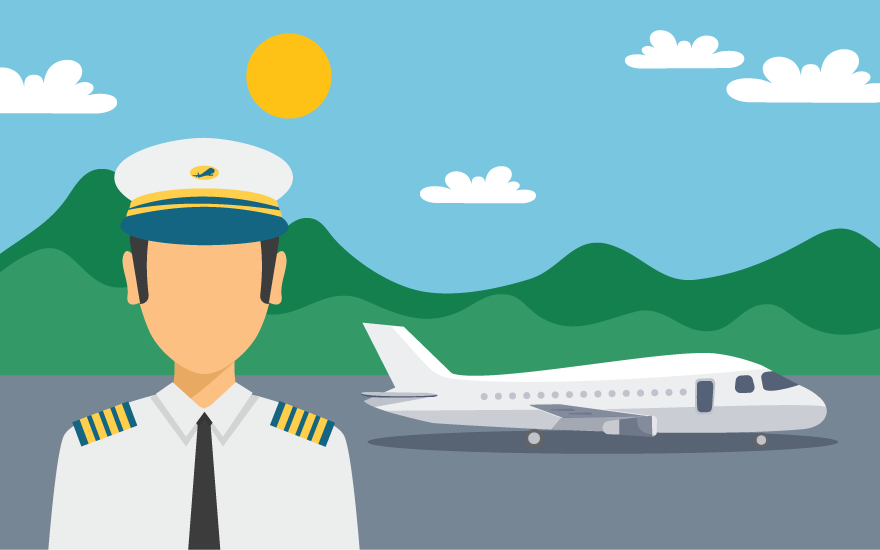COMMERCIAL PILOT
- INTRODUCTION
- CAREER OPPORTUNITIES
- COURSE
- COLLEGES
- SKILL SET
- ROLES AND RESPONSIBILITIES
Commercial pilots fly aircrafts that carries passengers and cargo.
They may also work in other industries and have duties like monitoring traffic and participating in rescue operations.
The job of a pilot is a highly specialized one.

It requires knowledge of air navigation, interpretation of meteorological reports, operating sophisticated electronic and mechanical controls, leading the aircraft under adverse circumstances, and being a leader to the flight crew and passengers under climatic and other emergency situations.
- First Officer
- Pilot
- Co-Pilot
- Commercial Pilot
- Airline Pilot
- Captain
- Commuter Pilot
- Experimental test Pilot
- Student Training License-The duration of this course is six months.
- Private Pilot License- It is one year duration course
- Commercial pilot License –The duration of these course is 3 years
- Government Aviation Training institute-Bhubaneswar
- Coimbatore Flying club,-Coimbatore
- Indian Aviation Academy –Mumbai
- Jamshedpur Co-operative flying club Ltd-Jamshedpur
- All India institute of Aeronautics(AIIA)-Dehradun
- Rajiv Gandhi Aviation Academy- Secunderabad
- Ahmedabad Aviation and Aeronautics-Ahmedabad
- Government Flying Training School –Bangalore
- Indira Gandhi Rashtriya Uran Akademi Bareli
College - Indira Gandhi Rashtriya Uran Akademi Bareli
Course–Commercial Pilot License (CPL) coupled with instrument and multi-engine endorsement.
Eligibility Qualifications –Minimum age of joining the course is 17 years.
10+2 equivalent with Maths,Physics, English
With 55% marks in Physics and Math’s-For General Candidates
With 50% marks in Physics and Math’s- For SC/ST/ OBC Candidates
English for all categories.
Admission Process:
Written Entrance Examination
Pilot Aptitude Test
The Interview by an Interview Board
Duration- 2 hours
College –West Bengal Flying Training Aviation
Course –Commercial Pilot License
Duration -15-18 months
Eligibility– 10+2 with PCM
Age –Minimum 17 years
Admission Process – Should pass the Aptitude test by the Institute
College - Indira Gandhi Institute of Aeronautics-
Course- Pilot Training (Commercial Pilot License)
Duration- 1 year
Eligibility - 16 years minimum age, 10+2 with PCM with 50% marks
Admission Process –Pilot Aptitude test (you will need to solve in 30 minutes and submit it online itself. IGIA shall process the test and you’ll get your test result the next working day.)
College –Rajiv Gandhi Aviation Academy-Hyderabad
Course – Commercial Pilot License
Duration- 18 months
Eligibility – 18 yrs. with minimum age,10+2 with PCM(50%)Marks
Admission Process –WOOMBAT Test
The WOMBAT Situational Awareness and Stress Tolerance Test is a modern psychological assessment tool for selecting complex-system operators such as pilots, air traffic controllers, ship and train operators etc.
College- Government Flying Training School-Bangalore
Course –Commercial Pilot License
Duration – 24 months
Eligibility -17years minimum age, 10+2 with PCM with 60% marks
Admission Process - Written Test+ Interview +Pilot aptitude test and Medical Class-II
As a commercial Pilot, you will have-
- Lots of Patience
- Ability to stay focused.
- Good Physical fitness
- Ability to quickly and accurately assess a dynamic and rapidly changing situation
- A good Memory
- Good study habits and the propensity to keep learning
- Discipline to follow established procedure
- Being a Team Player
- Strong communication
- Problem solving and observing skills
- Good depth perception and reaction time, ability to operate computer and navigation systems.
- Fly commercial planes from one destination to another
- Monitor aircraft systems and coordinate with on-ground airport authorities
- Study and deal with maps, technology and planes
- Send and receive information to the crew flying in an airplane and staff on ground
- Check weather and flight plans
- Work for long hours and in shifts, often being away from home & family for several days
- Ensure safe and efficient operation of the aircraft and the safety of crew members and passengers
- Brief cabin crew before a flight takes off and maintain regular touch with base people through out the flight
- Respond swiftly to environmental changes and emergency situations
- Update aircraft log book and write a report at the end of a flight







